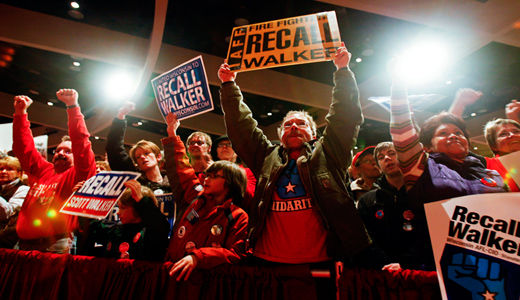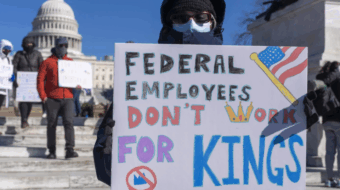
Rick Scott of Florida. Paul LePage of Maine. Rick Snyder of Michigan. John Kasich of Ohio. Tom Corbett of Pennsylvania. And, above all, Scott Walker of Wisconsin.
As the 2014 campaign passes Labor Day, those governors – all anti-worker and anti-union, all right-wing and all elected in the 2010 GOP sweep – are top targets this fall.
The emphasis on governors is part of a tactical shift this year by unions and their allies. With Congress gridlocked and likely to remain so, and with state legislatures gerrymandered to produce GOP majorities from now through 2020, the governors’ races are where it’s at.
AFL-CIO President Richard Trumka cautions that just because the top targets in most races – for governorships, Congress or legislatures – are Republicans does not mean organized labor will automatically support Democrats.
“We don’t work for any candidate,” he told the Unite Here convention in Boston. “We’re not building power for any political party. Not the Democratic Party. Not the Republican Party. We’re building power for working people, pure and simple. We’re looking at the long view.
“Yet I promise nobody will work harder to elect the leaders who make the right commitments, and nobody will work harder to defeat those who don’t, regardless of political party. We’re not going to hold our nose and endorse Democrats, just because they have a D next to their name. That’s not good enough.”
One example, from a U.S. Senate race, not a gubernatorial race: In swing-state – but unionist-light – North Carolina, the Fire Fighters are sitting out the race between Democratic Sen. Kay Hagan and Right Wing GOP State House Speaker Thom Tillis after Hagan welshed on past promises on key votes.
And Illinois unions are upset with incumbent Democratic Gov. Pat Quinn on issues ranging from pensions to collective bargaining rights. The question is whether his Republican foe, Bruce Rauner, is so Right Wing that his stands will drive Prairie State unionists out into the streets and to the polls for Quinn again. Unions were responsible for Quinn’s narrow 2010 win.
But there is no shortage of targets, or issues, for workers and their allies to run on.
GOVERNORS
Wisconsin’s Walker tops the takeout list, again, after a narrow election win in 2010 and a failed recall vote two years later. But in between came Walker’s budget shenanigans, the stripping of 200,000 state and local public workers of their collective bargaining rights, a dismal jobs creation record, anti-woman legislation, and an attempted “Voter ID” law.
All of this has led to a statistical tie in the polls between Walker, who thinks he could ride his union hatred and Right Wing schemes to a GOP presidential nomination in two years, and business executive Mary Burke, a former Democratic state cabinet official.
“Walker can’t run on a record of attacking worker rights, failing to create jobs, denying justice to veterans who have fallen victim to asbestos disease and lowering wages and living standards for all workers, so he is resorting to gerrymandering and voter suppression tactics in an blatant attempt to rig elections,” Wisconsin AFL-CIO Secretary-Treasurer Stephanie Bloomingdale said earlier this year.
“Burke knows that respecting workers’ rights to organize in both the public and private sector is good for the economy and good for workers. We need a governor that will stand with workers and fight to raise wages so we can grow our economy from the bottom-up and middle-out,” added state fed President Phil Neuenfeldt when the Wisconsin AFL-CIO endorsed her.
Wisconsin’s unions have embraced Burke even though she has not promised to roll back all Walker’s union pension cuts if she’s elected. His other measures hurt: Estimates say public union membership fell by up to 40 percent in Wisconsin after Walker’s law took effect.
Ohio’s Kasich also has presidential thoughts, which may be boosted by the GOP’s decision to hold its 2016 convention in heavily Democratic Cleveland. But first Kasich, who tried a Walker-like anti-collective bargaining law and a voter ID law, too, has to clear this year’s vote against Democratic Cuyahoga County (Cleveland) Executive Ed Fitzgerald.
Unionists have some hope of derailing Kasich: They petitioned his anti-collective bargaining law to a referendum and beat it, garnering more than 60 percent of the vote. Ohio’s voter ID law was headed for another referendum when courts stepped in to stop the law.
Pennsylvania’s Corbett has no presidential ambitions. He’s trying not to get swamped. He too, pushed anti-union laws through a GOP-gerrymandered legislature, slashed state funding for public schools and is trying to destroy the Philadelphia school system through a handpicked commission that is recommending all sorts of corporate-backed schemes. State courts have thrown out the GOP’s voter ID law in the Keystone State, at least for now.
All this has led to mass protests in Harrisburg, to the arrest of AFT President Randi Weingarten for demonstrating with her Philadelphia teachers – and to “favorable” poll ratings for Corbett of somewhere around 15 percent. The state fed strongly endorsed first-time candidate Tom Wolf, a business executive, after he beat experienced politicians in the Democratic primary and union PACs are spending at least $1 million for him. Wolf promised an end to “business as usual” in Harrisburg.
Maine’s LePage is almost as unpopular as Corbett. With moves large and small – he even stooped to ordering removal of a pro-worker mural from the state Labor Department’s office – LePage has antagonized Maine workers and unions. The catch is that LePage won a 3-way race in 2010 and may benefit this year from a rerun of that split.
There’s a rerun of sorts in Florida, too. Republican incumbent Scott faces his predecessor, Republican-turned-Democrat Charlie Crist. Crist always was non-ideological, embracing Democratic President Barack Obama’s health care law vocally, and Obama literally on a presidential visit after a disaster. That’s why Crist lost the 2010 U.S. Senate race to Tea Party-backed Republican Marco Rubio. But now Crist is even walking picket lines, and Sunshine State unions are solidly for him.
Michigan’s Snyder touted himself as a problem-solver in 2010. But he showed his anti-worker credentials, signing a right-to-work law the Republican state legislative majority passed in a 2012 “lame duck” session. He also pushed through abolition of teacher tenure. The Michigan Building Tradesman counted 37 separate pieces of anti-worker legislation in Lansing.
Most importantly, Snyder jammed through a law to let the state declare a local government has fiscally “failed,” and allowing him to appoint an overseer – a czar – with the power to sell assets, rip up union contracts, cut pay and abolish pensions, unilaterally. Not by chance, the czar-takeovers law was used against majority-minority cities and governments, including those that are unionized, such as Detroit and Grand Rapids.
Most other governors of both parties, except Quinn in Illinois, appear, two months out, to be relatively safe. Quinn’s foe, Rauner, a businessman with some questionable deals in his background, wants to reduce the state’s minimum wage and turn state workers’ pensions – a flash point of bitterness between Quinn and unions – into 401(k) accounts, for example.
Several Republican governors, such as Kansan Sam Brownback, had to survive challengers from within their own parties. California Gov. Jerry Brown (D), who has worked with the Democratic-dominated state legislature to pass a raft of worker-friendly laws, is expected to coast to re-election, as is New York Democrat Andrew Cuomo.
Pro-worker Connecticut Democrat Dannel Malloy – who gained national notice for marching on a picket line with locked-out nursing home workers – is not personally popular, but will benefit from the tea party vs. others GOP fratricide in the Nutmeg State.
U.S. SENATE
With virtually everyone conceding that redistricting and retirements will keep the U.S. House in Republican hands, the focus is on the Senate, where up to a dozen key races could determine whether pro-worker Democrats keep their current 53-45 majority. Two independents, Bernie Sanders (Vt.) and Angus King (Maine) caucus with the Democrats.
That lead is virtually guaranteed to shrink: Democrats hold 21 of the 35 Senate seats up this year, and at least two – South Dakota’s open seat and Montana’s with a gubernatorial appointee to replace inconsistent Democrat Max Baucus – have been virtually written off.
Senate control is important. Without it, pro-worker allies would have virtually no chance of either getting legislation they want, such as the Employee Free Choice Act, equal pay for equal work or comprehensive immigration reform. And Democratic President Barack Obama would be unable to get any nominees through – including nominees for the National Labor Relations Board when current members’ terms expire.
Among senators seeking re-election, two Democratic women, North Carolina’s Kay Hagan and Louisiana’s Mary Landrieu, are considered the most endangered. Hagan may have the better shot: North Carolina is a swing state and workers and their allies – except for unions she alienated – are energized by the “Moral Monday” movement against the GOP-dominated legislature. Hagan is hanging the legislature’s record around Tillis’ neck.
“The way GOP hardliners see it, Tillis is the Speaker. He speaks, and everybody else shuts up and listens,” says Steel Workers President Leo Gerard. “These lawmakers don’t represent constituents in a constitutional democracy. They are overlords. And as rulers over the people, they’ve awarded themselves the power to muzzle and handcuff anyone who disagrees with them.”
Landrieu is in more trouble. The union movement in Louisiana is weakened by the one-third decline in New Orleans’ population after Hurricane Katrina and emasculation of the South’s largest union local, the New Orleans Teachers, through GOP Gov. Bobby Jindal’s dismantling of the city’s public school system. Landrieu’s GOP foes are also pounding away at her votes for the 2010 Affordable Care Act, which is extremely unpopular in the deep-red state.
Republicans think the health care law is a winner for them in races where Democrats hold U.S. Senate seats in red or swing states: Alaska’s Mark Begich, Arkansas’ Mark Pryor, Minnesota’s Al Franken, New Hampshire’s Jeanne Shaheen, Colorado’s Mark Udall and three open Democratic-held seats, in Iowa, West Virginia and Michigan.
Democratic Secretary of State Natalie Tennant is the underdog in now-red West Virginia, while former Rep. Gary Peters (Mich.) and current Rep. Bruce Braley (Iowa) are in toss-up races in the other two states. The Mine Workers are still a hefty electoral presence in West Virginia, union President Cecil Roberts’ home state. Begich is helped by Alaska’s heavy unionization. Sen. Lisa Murkowski, R-Alaska, who votes more often with workers than most Republicans, won 2010 re-election as a write-in – after a tea partyite beat her in the primary.
Vote analyses show GOP Rep. Cory Snyder, Udall’s foe, is one of the two most ideological Republican representatives challenging Democratic incumbents this fall. The other is Tom Cotton in Arkansas, opposing Pryor. Cotton is slamming Pryor’s vote for the ACA, while Pryor – like Landrieu – touts his differences with the Obama administration Unlike Landrieu, Pryor has deep splits with Arkansas unions, on issues such as raising the minimum wage.
While the GOP hopes to gain the Senate by winning Democratic-held seats in red or swing states, Democrats have high hopes for two female U.S. Senate candidates in red states: Michelle Nunn in Georgia and Secretary of State Alison Lundergren Grimes, challenging Senate Minority Leader – and chief obstructionist – Mitch McConnell in Kentucky. Neither woman is a guaranteed pro-worker vote, but both would be improvements, unionists in their states know, over McConnell and over retiring GOP Sen. Saxby Chambliss (Ga.).
Photo: The labor movement is putting emphasis on defeating Republican Scott Walker, the Wisconsin governor whoe attacks on unions spurred the historic protests in Madison. Andy Manis/AP










